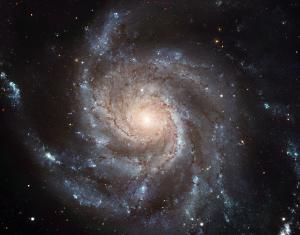Post
Island Universe
17 September 2013
 European Space Agency & NASA
European Space Agency & NASAThe visible universe is vast. It is 93 billion light years across, and contains more than 100 billion galaxies. The average galaxy contains about 100 billion stars, and untold numbers of planets. Yet a century ago there was serious doubt among many astronomers that the universe was much more than 100,000 light years across. Arguments about whether the universe was small or large became known as the Great Debate.
It is often known as the Shapley-Curtis debate, so named after Harlow Shapley and Heber Curtis, and a public debate they had in 1920. Shapley, you may remember, used observations of globular clusters to correctly show that the Sun is not the center of our galaxy. Curtis was an astronomer who studied nebulae, as well as solar eclipses.
The debate centered on the distance to certain nebulae. At the time, “nebula” referred to anything (excluding comets) that appeared “fuzzy” rather than distinct like a star or planet. So things like the Orion nebula (a stellar nursery), the Crab nebula (a supernova remnant) were considered nebulae just as they are today, but what we now call galaxies were also known as nebulae. The Andromeda galaxy, for example, was known as the Great Andromeda Nebula.
Curtis argued that Andromeda and other spiral nebulae were in fact “island universes”, similar in size to our own Milky Way “universe”. This would mean that not only were these nebulae 100,000 light years across or more, they must be millions of light years away. He based this argument on the fact that more novae were observed in Andromeda alone than were observed in the entire Milky Way. Why would that be the case if Andromeda were small and close. He also noted that some spiral nebulae had rather large redshifts, meaning that they were moving much faster than other objects in the universe.
Shapley argued that what we now call the Milky Way galaxy was the bulk of the universe. Spiral galaxies such as Andromeda must be relatively close and small. He based this view on several points. In 1917 Shapley and others observed a nova in the Andromeda nebula. For a brief time the nova outshined the central region of Andromeda. If Andromeda were a million light years away, as Curtis contended, then this nova (we now know it was a supernova) would need to be far brighter than any known mechanism could produce. There were also observations of the Pinwheel galaxy, seen above, by Adriaan van Maanen. He claimed that the Pinwheel had visibly rotated over the span of years. If the Pinwheel was rotating as van Maanen observed, then it couldn’t possibly be 100,000 light years across. For an object that large to rotate in a matter of years the stars would need to move faster than light.
After the debate the general opinion was that Shapley had won. His own observations of the shape of the Milky Way and the 1917 supernova, and van Maanen’s observations gave the small universe model solid footing. Besides, the idea that objects could be millions of light years away seemed patently absurd.
But Shapley was wrong in this case.
In 1912 Henrietta Leavitt discovered that Cepheid variable stars vary at a rate proportional to their brightness. Her work wasn’t widely accepted initially, but after more prominent astronomers such as Edwin Hubble supported her results it became accepted as an observational tool.
In 1925 Edwin Hubble used Leavitt’s period-luminosity relation to precisely determine the distance to the Andromeda galaxy. He demonstrated conclusively that Andromeda was about 2 million light years away. He went on to show that other “nebulae” were in fact distant galaxies. By 1929 Hubble demonstrated a relation between the distance of a galaxy and its redshift, and thus that the universe was expanding.
Thus we came to know that our Milky Way is an island galaxy in a much larger universe.